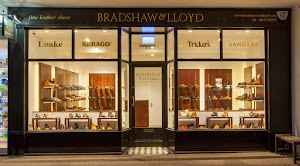All the great English shoemakers are using stud rubber soles in their footwear these days, the best known of which is Dainite. It has long been known that the traditional method of shoe construction, known as Goodyear welting, is by far and away the best and it is nothing new that rubber soles have been used alongside leather. However many traditionalists are still wary of rubber soled shoes. The fact is that rubber soles made by the likes of Dainite are far harder wearing than even the tightest grained and oak bark tanned leather soles. Additionally when leather soles do wear very thin water can begin to penetrate through the leather. This is not an issue with rubber soles which maintain their weather proofing until a hole actually appears. Rubber soles also provide really good grip.
What is important to the comfort and longevity of a shoe is that the foot should be encompassed in leather so that it can breathe. It should also sit on a full leather insole which along with the cork filler between the insole and the sole will gradually mould to the shape of the foot to produce a glove-like fit. Although the soles may be of Dainite rubber the welt in the best shoes should always be made of leather. Only a leather welt allows the repairer to re-sole the shoes on numerous occasions.
At Bradshaw & Lloyd we offer a variety of shoes with Dainite rubber soles from Loake, Sanders and Trickers.


